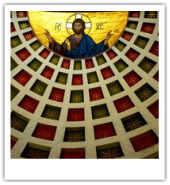 I COULDN'T get my financial act together this Easter to escape the throngs who are descending on Rome for the Holy Week. This is my third consecutive Easter in Europe, but the first that I find myself in Rome, as much as I had wanted to escape. Perhaps I will, even if just for a day or so, but at the end of the day it doesn't really bother me. Rome is big enough to be able to avoid a lot of the crowds who come in to soak up the atmosphere and to feel physically closer to God. Last week I went to a village mass service in the far south of Lazio. I tagged along with some devout relatives and although it wouldn't have been my way of choosing to spend a Sunday morning, I didn't find it offensive. I love to observe people and although the service was all fine and well, it was more interesting for me to watch the latest generation of teenagers flirting in the gallery where I was sat. When they eventually bored me I started to focus on the architecture of the church, which felt like a modernized minimalist sixties building, just done on the cheap. The other day I was thinking about how this city in particular has come to be associated with Christianity, and how ostensibly, it's an association that began as in import of a foreign culture or tradition. Of course, Catholicism developed into something completely of its own here, but I couldn't help but think about the way in this country in particular, people picked up the ball and ran with the idea, creating a huge visual and structural heritage and iconography along the way. It would be like South Africa deciding wholesale that it was going to be Buddhist and then over the course of a couple of millenia reshaping the land so that it was completely dotted with temples, Buddhist icons on street corners, mini shrines built into the facades of apartment buildings. It's fascinating really. A cursory check will tell you that there are almost 1000 churches in Rome. This is an interesting figure, because it is well documented that during the Roman era the city's population peaked at over a million, making it at one stage the world's biggest city, but with the fall of the Roman empire it contracted to less than 50,000 right through until the mid 1900s when Rome's population first returned to seven figure numbers. Christianity didn't become the official religion in ancient Rome until the time of Constantine, which was in the later part of the Roman era, long after the Tetrarchy had been established, splitting Rome's power base. The majority of Rome's churches date long after the Roman era, and arose with the shift of Rome's history towards the papal state. If you take a walk around the city centre, you will find church after church, often one annexed to the other, and it would take some imagination to think of how these would all be filled with parishioners and not with bureaucrats. But the pilgrims still come, and this city has a fantastic legacy of Christian inspired cites that run alongside its Roman and Etruscan heritage. The point for me this weekend will be to find a way to avoid too many of those 1000 churches and the thousands of pilgrims who, if not here to fill the temples are here to fill the adjacent piazzas.
0 Comments
Your comment will be posted after it is approved.
Leave a Reply. |
Dave
|
|
|
Dave Di Vito is a writer, teacher and former curator.He's also the author of the Vinyl Tiger series and Replace The Sky.
For information about upcoming writing projects subscribe to the mailing list. Dave hates SPAM so he won't trouble you with any of his own. He promises. |




 RSS Feed
RSS Feed